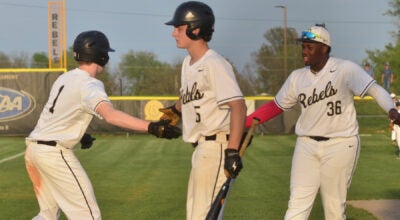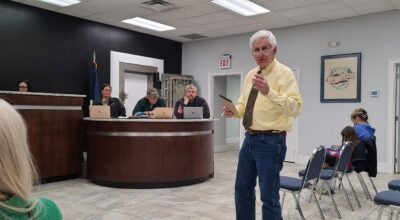Use of force sometimes necessary for officers
Published 4:40 pm Thursday, September 10, 2020
Editor’s note: This is the fourth in a series of articles written to share the experience of members of the current Danville Police Citizens Police Academy. The 10-week academy will teach the members about all aspects of local police work.
Although it is not the first option in an encounter, the use of force is sometimes necessary for police officers. Danville Assistant Police Chief Glenn Doan shared that message with members of the department’s citizen police academy Tuesday night, and his message was simple.
“We use the minimum amount of force necessary,” he said. “Use of force is not pretty. It never is, no matter how minimal it may be, no matter how much injury is sustained by the officer or the subject, or if no injury is sustained at all, which is always our goal.”
So far this year, Danville Police officers have used force 13 times, according to Doan. He said the instances have involved nine white males, one white female and three black males. The oldest was 56 years old, while the youngest was 24. Of those incidents, nine involved the use of a Taser.
Doan said use of force is based on the situation, and officers take a lot of factors into consideration before deciding to use it.
“There’s no single, universally agreed-upon definition of use of force. Can you imagine that? In 2020, there’s no universally agreed-upon definition of use of force. How long has policing been around, and we still haven’t come up with it yet? The courts haven’t come up with it, the Supreme Court hasn’t come up with it,” Doan said. “This is how the International Association of Chiefs of Police describe it — It’s the amount of effort required by police to compel compliance by an unwilling subject.”
Most officers in Kentucky, and all trained at the Department of Criminal Justice Training Center in Richmond, are taught to follow the use of force continuum, which dictates what level of force can be used and when it can apply to a situation. Doan said an officer’s actions also have to be within boundaries of the U.S. Constitution, as well as state laws and statutes.
“We have to have all of that in mind. If I just say turn around, you’re under arrest, and you say no, I can’t just punch you in the face,” Doan said. “First of all that would be a violation of your civil rights because I’ve used too much force to take you into custody. But if I grab you by the arm and tell you you’re under arrest and you swing at me, and then I punch you in the face, I’m OK.”
Many people might think force is all about physical activity, but Doan explained that it could be something as simple as an officer’s presence on a scene and work up to giving verbal directions, and then eventually lead to physical encounters if necessary.
“If I tell you that you’re under arrest, turn around, you’ve got a warrant. If they stand there and continually say no, or just refuse to comply, I can’t just stand there and say it all day long. Eventually, something has to happen. We’re either going to have to grab this suspect and take them into custody, and they’re either going to comply when we do that, or they’re going to resist further,” Doan said. “Based on their action, then you’ll get our reaction. I’ve said it many times before, most of the time we as police officers do not dictate what’s going to happen. The person we’re dealing with does. They’re the ones in control of what happens.”
A suspect can cause officers to move further into the continuum by their activity. Simply standing in a position that looks threatening to an officer can lead the officer to the next steps. Doan said if a suspect stands with their fists clenched and the officer feels threatened, that could be considered a crime known as menacing.
A suspect could use what is known as passive resistance, where the person does not fight the officers, but simply allows their weight to go dead and make it difficult for them to be taken into custody. That would allow police to use soft empty hand techniques, which include wrist locks, joint locks, and pressure points — all things that would have a low chance of injury but still gain compliance from a subject.
Doan was asked about the use of chokes, and he stressed that those would be considered deadly force.
“If I can choke you where I’m cutting off your airway, then I can shoot you. It’s not taught. It’s got to be a deadly force encounter where I’m saving my own life or someone else’s life if I can restrict the passage of air,” he said.
Doan added that there is a move known as a shoulder pin restraint that would allow an officer to apply pressure to a subject’s neck and cut off the blood flow, rendering the subject unconscious. He said the move is taught in the academy, but it’s a move he has never seen an officer have to use.
“I’ve been here 15 years, I’ve been a use-of-force instructor for a very long time in a bunch of different disciplines — we’ve not used it, I’ve never seen anybody use it. It would fall under a hard empty-hand technique, and you would need active aggression — you’re in a fight, somebody’s punching you, something like that. It’s a pretty intense situation before you would use that type of restraint. But chokeholds are not taught. If somebody applies one, they have not learned it through our type of training,” Doan said.
Hard empty-hand techniques would include strikes, such as punches, kicks, or knee strikes. Doan said officers are taught very specific ways to apply these techniques and very specific places on the body to apply them. He said they would normally be used when an officer is not in danger of being harmed, but when a subject is pulling away, pushing an officer or folding their arms and refusing to move or be taken into custody.
When a situation escalates farther, it can become necessary for the use of intermediate weapons. Those include Tasers, pepper spray and batons. Beyond that would be deadly force, which would include an officer’s gun.
Doan said officers have to remember that they are required to follow laws, and if a situation stops, they have to stop their actions as well.
“If they stop, I’ve got to stop. Just because it was lawful half a second ago doesn’t mean it’s lawful now,” he said.
An important tool for officers to use is simply talking. Doan said you have to be able to talk to people, and that can often eliminate the need for any type of force.
“Talking an intoxicated, 6-foot-5, 230-pound man into a car is a lot easier than fighting him into a car,” he said.
If an officer does determine that force is necessary, Doan said the officer has to be able to explain their actions.
“You have to be able to articulate why you did what you did in that situation. If you can and it fits all of this, then you’re good. If you can’t and you have no reason that you should have done it, and you maybe shouldn’t have done it, there’s going to be problems,” he said. “If we go above that and we don’t use the least amount of force necessary to accomplish what we need to accomplish, you can be looking at lawsuits, loss of job, loss of career, based on one decision.”
Baton training
Members of the class learned about use of the baton, and had the opportunity to participate in a drill with Doan in a protective suit used for training. He said the baton would only typically be used in an active aggression situation.
“When we train with batons, the way they train at the academy, there are certain areas you can hit. You aim for certain areas,” he said, adding that there are key spots such as the common peroneal nerve in the leg, which would help to quickly take down a subject.
Next up: Week 5 of the 2020 Danville Police Citizens Academy is scheduled to include tactics and safety, active shooter situations, firearms training, and building clearing, as well as demonstrations and class member participation.






